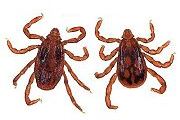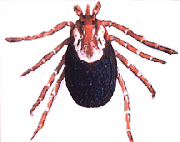Fleas
Fleas are a huge pest with more than 1 billion Dollars spent in USA a year on pest control. Flea bites causing itching, irritation and can also cause secondary diseases like tapeworms, dermatitis and even the plague.
A Female can lay about 25 eggs a day, and up to 800 eggs during her lifetime; fleas undergo complete metamorphosis, usually in 14 to 90 days.
What does a Flea look like?
Black or brownish-black, about one-twelfth to one-sixteenth inch long; six legs, with many bristles on body and legs; flattened body.
Habits: Found on cats and dogs year-round, but most common during warm and humid weather; readily attack and feed on humans; can jump as much as seven-eighth inch vertically, and 14 to 16 inches horizontally. |
 |
What do they like to eat? Blood!
Fleas are...
- ...carrier of many diseases; adults can live one to two months without feeding.
- ..transmitter of diseases such as epidemic typhus and bubonic plague, to name only a few.
- ..can carry tapeworms from dogs and rodents and occasionally transmit them to humans.
- ...generally less than three-sixteenth of an inch long.
- ...alive for more than 100 days, in which time a pair of fleas and their descendants can produce millions of offspring.
- ...consumers 15 times its body weight in blood daily. Females only!
- ...attracted to animals by body heat, movement, and the carbon dioxide they exhale.
- ... fast and can accelerate the equivalent of 50 times faster than a space shuttle does after liftoff.
- ...jumpers and can jump up to 150 times the length of their bodies - sideways or up - equivalent to a person jumping nearly a thousand feet.
How to get rid of fleas:
Because of their overwhelming capacity to reproduce, fleas can become nagging nuisances for homeowners. However, there are several precautionary steps which can help control these critters.
1. The safest and cheapest method of getting rid of fleas is to use a mixture of boric acid and salt. The powder should be sprinkled on carpets, bedding and areas frequented by pets. Boric acid acts as a desiccant and dries out the exoskeleton of the flea, but does not have any side effect on human beings or animals.
2. In areas with a high concentration of fleas, keep a bowl of soapy water below a table lamp. The fleas will leap towards the light at night, jump into the water and drown.
3. Vacuum clean carpets, bedding and other areas where the fleas are likely to lay eggs. After cleaning seal the residue in a plastic bag and dispose of it away from the house. If the bag is not sealed properly, the fleas will crawl back.
4. Insect growth regulators are hormones which prevent eggs from hatching and larvae from growing into adults. Methoprene and pyroproxifen are effective in reducing the population of fleas.
5. Citronella oil, eucalyptus oil, balsam, citrus peel extract, lavender oil and tea tree oil are some natural products which are effective insecticides for fleas.
6. Wash pet bedding and other furnishings once a week in hot soapy water to kill eggs and larvae. Try to reduce the contact between your pets and wild animals which may carry fleas. Flea dips and flea sprays like Frontline, Revolution and Advantage can eliminate fleas but may have side effects.
<< Back to Top >>
Ticks
American Dog Tick
Dogs are the preferred host of adults of this tick species, but they will feed on larger animals.
Symptoms appear 3 to 12 days after tick contact. There is a sudden onset of symptoms that include fever, headache, and aching muscles. A rash usually develops on the wrists and ankles on the second or third day of fever. The rash then spreads to involve the rest of the body, including the palms and soles. If you experience fever following tick contact, see your physician. It is important to receive the appropriate antibiotics as soon as possible if spotted fever is suspected. Most fatalities can be attributed to a delay in seeking medical attention.
It occurs throughout the easter and centeral United States. The American dog tick goes through an egg, larva, nymph, and adult stage during its development. While they may be found throughout the year, adults are most active during late April through May.
The immature stages may feed on these same hosts but prefer to infest smaller mammals such as meadow mice, squirrels, and chipmunks. All stages of the American dog tick will also feed on humans if given the opportunity.
<< Back to Top >>
The American dog tick does not transmit Lyme disease.
Although dog ticks do not carry Lyme disease, they are the main carrier of Rocky Mountain Spotted Fever in the midwest states.
Control of American dog ticks in outdoor areas is extremely difficult.
While several insecticides are labeled for outdoor tick control, they are usually not effective in eliminating large numbers of ticks in brushy, heavily wooded areas.
There are, however, some management techniques that can discourage a buildup of ticks in these areas.
Modifying the habitat is a more permanent approach to tick management.
Since ticks must be in areas of high humidity in order to survive, they are most commonly found in grassy, brushy, wooded, and shaded areas.
Therefore, reducing the humidity in these areas by keeping grass well-clipped, removing brush, and pruning trees to allow more sunlight to penetrate to the soil surface will discourage ticks from becoming established in these areas.
According to the CDC, more than 23,000 human cases of Lyme disease were recorded in 2002, with an estimated 9 out of 10 cases going unreported. Once infected with Lyme disease, a person may experience flu-like symptoms and develop a red rash in the shape of a bull's eye. Because the symptoms of Lyme disease so closely mimic the flu, it often goes undiagnosed and can lead to more serious health problems if left untreated.
<< Back to Top >>
The Brown Dog Tick
This is the most widely distributed ticks in the world.
It is unusual among ticks, in that it can complete its entire life cycle indoors. Because of this, it can establish populations in colder climates, and has been found in many different climates.
What does the Brown Dog Tick look like?
It is small, red-brown in color, uniform in color. Its mouthparts are easily seen when viewed from above.
The body is flattened and shaped like a tear drop. |
 |
Habits:
Many tick species can be carried indoors on animals, but cannot complete their entire life cycle inside. Dogs are the preferred host in the US . The adults attach to the ears and between the toes, and the larvae and nymphs are often found in hair along the back, however are not restricted to these parts.
Once an infestation occurs inside a home, it can grow very rapidly. Typically, a few ticks are brought into the house or from an infested kennel, open field or other place where infested dogs have been located. After the ticks have engorged on a blood meal, they drop form the host and seek some protected situation in the immediate surroundings.
<< Back to Top >>
For this reason, they may be found behind baseboards, under window and door moldings, in window pulley openings, or in furniture. All cracks and crevices in an infested premise must be treated for good control. This tick cannot overwinter in the more northern United States except within a heated structure.
A home can become infest if the family dog picks up ticks from an infested residence, boarding kennel, open fields, or similar place where other infested dogs have been located.
Another infested dog may visit the residence, during which time some ticks may drop off. In this case, the home and yard may become infested even though a dog is not generally kept there. Dogs do not become infested with brown dog ticks by direct contact with other dogs.
Ticks feeding on a dog drop off and molt before they will resume host-seeking behavior and attach to another dog.
<< Back to Top >>
How to get rid of Brown Dog Ticks:
1. The infested house and/or kennel should be thoroughly cleaned in order to eliminate as many ticks as possible. Vacuuming is very helpful inside.
Pet beddings and pet areas should be cleaned well.
2. Kennels, dog houses, and structures occupied by pets should be thoroughly treated to control ticks that have dropped off the dog and that reside in harborage areas.
Residual insecticide sprays and dusts should be applied carefully to all potential tick harborage areas.
Ticks like to reside in the upper portions of structures in cracks and crevices and the areas used by dogs.
Reference: http://doyourownpestcontrol.com/ticks.htm
<< Back to Top >>
Lice
What do Dog Lice look like?
Dog lice are flat, gray, wingless parasites that are about a twelfth of an inch long. Dog lice are very slow movers. In fact, they hardly move at all. Dog lice only affect the dogs in your home and are not capable of surviving off of cats and humans. |
 |
What are dog lice? Are they the same type of lice that affect humans? What is the most effective way of getting rid of dog lice?
Sometimes even a clean, well-groomed dog can play a host to different types of unwanted guests. One of these unwanted visitors is called dog lice. Dog lice infestation is not common among dogs in this country, especially those that live in a clean environment and get proper care and attention.
However, you should still be aware of their symptoms and know how to deal with the problem should it occur. Dog lice can cause severe irritation and illness to your dog. In addition, dog lice carry diseases and can cause complications such as anemia.
<< Back to Top >>
There are two types of dog lice:
- One type of dog lice concentrates on biting the skin and feeding on skin flakes
- The other type of dog lice feed on your dog’s blood. Blood sucking lice causes severe irritation because they penetrate the skin of your dog in order to feed.
Signs that your dog is infected with dog lice are heavy, intense scratching, and irritation that often results in bald patches. Dog lice are usually found on the area around the ears, neck, shoulders, and anus. Although dog lice are relatively large, you are more likely to spot their eggs in your dog’s hair. Lice eggs (nits) are easier to see because they are attached to the dog’s hair and look like white tiny flakes of dust.
<< Back to Top >>
Treatment:
Treating dog lice is relatively simple and easy due to the fact that they have not built up a resistance to insecticides. Your vet will more likely recommend an insecticide spray or bath to kill them. He may require you to cut off matted hair and wash your dog about once every week with the insecticide.
This procedure is then repeated until the itching is gone and there are no more visible lice eggs. If you have a puppy that is infected with lice, consult your vet first before starting on any kind of pesticide treatment or other type of medication.
To prevent further lice infestation and make sure that all the lice eggs have been completely eliminated, it is a wise idea to throw away all bedding that your dog has lain on during lice infestation and to disinfect the area where he sleeps.
Reference: http://www.puppythrill.com/blog/index.php/links
<< Back to Top >>
Mites & Mange
For centuries, "mange" was a word used to describe almost all skin diseases of dogs. A "mangy dog" was accepted as being a miserable, run-down and scrawny animal.
Today, however, mange is known to be a specific skin disease due to invasion of the skin by tiny parasites called mites. There are two common types of mites which cause mange: demodectic and sarcoptic mange. The two manges are quite different.
Demodectic Mange
Demodex mite
This is caused by the mite Demodex canis, and is the more common form of mange. Most healthy dogs have this mite present in small numbers as a normal inhabitant of their skin and it causes no problems.
Only when these mites multiply and populate the skin in their thousands do they cause trouble. Most dogs do not "catch" demodectic mange - it develops from mites already present.
Demodectic mange can progress from a simple skin condition to a severe problem if there is a failure of the dog's immune system to prevent spreading. This may occur in a debilitated dog or a dog suffering from another generalised disease such as distemper or infectious hepatitis.
<< Back to Top >>
At what age are dogs affected?
The disease occurs typically in young dogs less than 12 months of age, however, exceptions do occur.
Signs and diagnosis:
There are two distinct types of demodectic mange: firstly there is a mild form localised to only a few sites, usually around the head (especially the eyelids, corners of the mouth and under the jaw) and forelegs. Patches of hair loss are seen. There may be a slight itching, but often the dog is not concerned. Usually only one to five patches are present.
The second type is a severe form, where hair loss is widespread over the body, and is called "generalised" demodectic mange. This form is a serious problem and may be incurable in some dogs. When the resistance of the host dog falls, demodex mites may breed to produce tens of thousands of offspring. Frequently the skin becomes secondarily infected with bacteria, and pustules (swollen pus-filled pimples) develop. These may be itchy, causing further damage when the dog scratches itself.
Diagnosis of demodectic mange is made by a vet taking skin scrapings and observing large numbers of mites when the sample is viewed under a microscope.
<< Back to Top >>
Treatment:
Mild cases mostly clear up by themselves in about a month. For this reason, many different treatments have been claimed to produce a cure, but preparations containing benzyl benzoate, malathion, lindane and rotenone seem to be most effective. Treatment of generalised mange must be supervised by a vet, since these drugs are toxic. In severe cases, treatment is prolonged and may be unsuccessful. However, many dogs improve with age and the problem may resolve once the dog is sexually mature.
Sarcoptic Mange
Sarcoptes mite
Scabies is a mange caused by a mite called Sarcoptes scabei. This mange is very different to demodectic mange.
Diagnosis and distribution:
Dogs of any age may be infected. The areas most commonly involved are the ears (especially the edges of the ears) and the elbows, although any area of the body may be affected. These areas become red and itchy. Hair usually falls out and the skin becomes flaky and sometimes crusty. The dog develops an intense itch and will rub and scratch vigorously at the affected areas.
<< Back to Top >>
Distribution of Sarcoptes
Who can catch scabies?
Scabies is highly contagious to other dogs and may even infect owners if they are in close contact with their dog.
Treatment:
Treatment is always necessary. Scabies will not get better by itself and the intense itching causes dogs to mutilate their skin. Dips such as malathion, ronnel or lime sulphur can be applied weekly until the skin clears up. This may take a month or more. Ointments containing benzyl benzoate, sulphur and other drugs which kill mites are available from vets and some pharmacies. These can be used if only small areas are affected. Spot-on preparations, such as Revolution, can also be used.
Ear Mites
Inflammation of the ear canal, or otitis externa, can be caused by a number of factors, such as parasites, microorganisms, foreign bodies, tumors, and underlying dermatological (skin) disease. Ear mites are parasites that often can cause otitis externa. However, the incidence is much lower than often thought. In my experience, less than 10 percent of all ear problems in dogs that I have treated are the result of ear mites. Ticks and fleas are other examples of parasites commonly found in canine ear canals.
Ear mites can be problematic, however. An elderly gentleman once explained that he thought his dog was "going crazy." He said his old setter would sleep by the fireplace. Suddenly it would jump up yelping and begin to run around the room in circles. After several minutes of hysterical commotion, the dog would lie down again and go back to sleep.
<< Back to Top >>
After pondering the situation, I examined the dog's ears and found a heavy infestation of ear mites. It appeared that as the heat from the fire warmed the dog's ear canals, the mites would became agitated and began to move around. As the old setter would run around the room, the ears would cool down and the mites would stop their activity. Then the dog would return to the fireside.
An important point to remember is that ear mites are parasites. Therefore, for your dog to have ear mites, it must have had direct contact with another pet infested with ear mites. So if your veterinarian diagnoses one animal in your house with ear mites, it is best to have all of your animals examined for possible infestations.
<< Back to Top >>
References:
WorkingDogs.com
|





